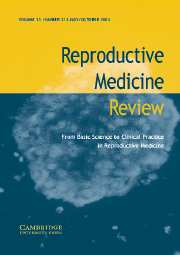Article contents
Putative intraovarian regulators
Published online by Cambridge University Press: 03 June 2009
Extract
Ovarian folliculogenesis is an exponential process marked by dramatic proliferation and differentiation of the somatic and germ cell elements of the follicle. Although the central roles of gonadotropins and of gonadal steroids in this explosive agenda are well accepted, the variable fate of follicles afforded comparable gonadotropic stimulation suggests the existence of additional intraovarian modulatory systems. Accordingly, consideration must be given to another set (or sets) of regulatory principles that may provide these missing modulatory loops. The work of multiple contributors favors the hypothesis that these modulatory loops are comprised of a host of peptidergic principles which engage in situ in the modulation of ovarian growth and function. In its capacity as an intraovarian regulator, a given agent may be acting independently of, as an amplifier of, as an attenuator of, or even as a mediator of, gonadotropin action. Together, gonadotropins, steroids, and locally derived peptidergic principles form a triad that modulates the growth and differentiation of ovarian follicles (Figure 1).
- Type
- Articles
- Information
- Copyright
- Copyright © Cambridge University Press 1996
References
- 1
- Cited by


